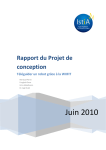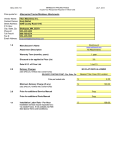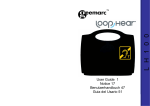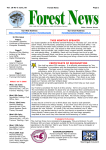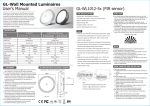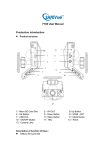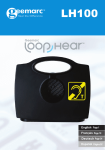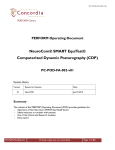Download DESIGN OF A SEATED BALANCE TRAINING DEVICE
Transcript
Multi-Disciplinary Senior Design Conference Kate Gleason College of Engineering Rochester Institute of Technology Rochester, New York 14623 Project Number: P10005 DESIGN OF A SEATED BALANCE TRAINING DEVICE Rochelle Perry Industrial Engineer Team Lead Andy Caola Computer Engineer Michael Davies Mechanical Engineer Jeff Hansley Electrical Engineer Luke Holsen Mechanical Engineer NIOSH – National Institute for Occupational Health and Safety ABSTRACT The goal of this project is to develop a balancetraining rehabilitation device for clients of the Physical Therapy Clinic at Nazareth College. Current methods of balance training include a standing Balance Master device and a highly subjective method of asking the patient to reach to a target held by the therapist. This new device has been designed to close the gap between these methods by providing an objective measure of reaching ability for primarily wheelchair bound individuals. It will give the patient illuminated targets at challenging distances and patterns of reach, and it will be easy to use for both the therapist and the client To accomplish the goals of this project two structures were built for the clients to reach to equipped with capacitive buttons that will require no force from the patient to activate, and a game is in place to illuminate the buttons and give feedback to the physical therapist. The outer shell of the second tower is completed, and plans are in place for future wiring and game design integrating the two towers. NOMENCLATURE RGB LED – Red Green Blue Light Emitting Diode. A semiconductor diode emitting light when conducting current in red green and blue. 3DSSPP – 3D Static Strength Predication Program which provides requirements for tasks such as lifts, presses, pushes, and pulls JTAG– Joint Test Action Group – Olimex MSP430 JTAG-ISO Programmer- IEEE Standard 1149.1 BACKGROUND This project aims to develop a balance-training device to be used by the physical therapy teaching clinic at Nazareth College. The system will train clients with disabilities that require them to use a wheelchair. The device specifically can be used for clients with spinal cord injuries, multiple sclerosis (MS), lower extremity amputation, or for anyone confined to a wheel chair. At the clinic the physical therapy students are taught to use various forms of balance training devices to assess patient ability to move in certain planes and reach in movements similar to daily tasks. Research shows that assessing a patient’s ability to balance can be directly related to their chances of falling. The clinic uses training to put clients in positions that could potentially make them fall so they can learn how to correct the movement on their own. Copyright © 2010 Rochester Institute of Technology Proceedings of the Multi-Disciplinary Senior Design Conference In order to assess the need for balance training at the clinic, an assessment was made of the current methods of balance training by the physical therapists (PT) and clients with various disabilities. Table 1 contains the advantages and disadvantages to the benchmark products used at the clinic. • Simple to use • No set-up • No storage space • Objective measure of patient progress SMART Balance Master [1] Nintendo Wii • Stimulating Game Fit [2] • Too much for clients with low cognitive ability • Specifications • No objective measure of patient progress • Boring • Standing only • Difficult to use • Frustrates patient • Nintendo does not support “Physical Therapy” • Difficult to determine what actually training To fill the gaps at the Physical therapy clinic there was a need for a device for seated balance training, that was simple to use, and visually stimulating to the patient. The unit would be designed such that once it is set up the therapist can focus on the patient rather than the object they need to reach. Being able to quantify the patient’s ability to balance will help track the patient’s progress throughout their therapy sessions. The completed device as demonstrated by a student can be seen in Figure 1 Easy to use for Patient and Physical Therapists Easily Stored and Portable • Table 1: Benchmark Balance Training Devices Device Advantages Disadvantages PT Hold Device Page 2 In order to meet the customer’s primary needs, a list of measurable engineering design specifications were created, as well as marginal and ideal values for each. These are noted in Table 2. Table 2: Engineering Specifications Engineering Metrics Importance Game response time (to/from device) 3 Distance from patient to target 9 Min size patient fit 1 Marginal Value Ideal Value 1000ms 3500ms 24” 45” 36” 40” Max size patient fit Height of device Time to sanitize 3 3 1 50” 40” 45sec 60” 60” 60sec Withstand “tip test” Max tilt angle before fall Time to understand program Set up time Time to disassemble Special confines 3 9 3 9 3 3 5cycles 15deg 5min 2min 1min 3ft2 10cycles 20deg 2.5min 1min 3min 2ft2 Force needed to move 3 15lbs 10lbs Optical visibility 9 30lumens 35lumens volume 1 40dB Button sensitivity 9 .2lbs .1625lbs Parts that can be replaced 9 75% 100% 30mins 15mins .5” .25” Time to set up program 3 Showing accuracy of patient location 9 60dB Concept Selection Figure 1 Final Tower Design PROCESS Brainstorming sessions were held to generate concepts that could meet the customer’s needs and the set specifications. The first design was a tri-fold design target that would give the patient a grid of lights to reach to. The design involved a game that would illuminate buttons on the tri-fold and track the patient’s ability to hit the targets. Figure 2 shows the prototype of this design, which was also constructed and shown to clients at the clinic. Customer Needs In order to begin the design process, the customer needs were first assessed. It was determined that the clinic needed a device that met the following requirements: • Rehabilitative • Safe • Adjustable Project P10005 Figure 2 Tri-Fold Target Design After building a mock-up of the device out of cardboard and speaking with clients about its functionality, it was determined that the design missed four very important customer needs. It was too large, it would take up too much space in the clinic, it wouldn’t be portable, and it was very overwhelming for the patient to sit in front of. Through more brainstorming and combining components of some ideas, a modular tower design was developed and selected. A selection matrix was used to decide on this design using the customer needs as criteria. As seen in Figure 3 the concept was designed to have a minimum of four individual posts, that would cut back on space and not be overwhelming to the patient. Each post could have three light-up buttons, and be individually wired into a central USB. The posts would be easily moveable to allow for simple adjustment and easy storage. Figure 4 Modified Tower Design The selected design entailed a multiple tower design acting as targets for the clients to reach to. The towers would illuminate in various patterns that challenge and train the patient’s balance. Ideally the customer wanted two towers to require the patient to reach from side to side. The scope of this project included implementing and testing the technology behind one tower, which could eventually be turned into a multiple tower game. Each tower will eventually be remotely connected to the main tower. Analysis Tower Structure To develop an optimal tower design, many detailed assessments were made. Similar to choosing the main project concepts, the customer needs and engineering specs were considered in choosing each component of the detailed design. Figure 3 Initial Tower Design After demonstrating some preliminary designs with customers and subject matter experts, it was noted that some clients may have limited strength to “push” buttons, and the few feet between each tower would not track the incremental change at each physical therapy session. As a result it was suggested to have a tower with one continuous button tower using capacitance buttons. Figure 4 shows the modified tower design with multicolor LED lights between capacitance buttons on the tower. The lights would light up in different colors based on the ability for the patient to reach buttons on the tower. The main considerations when selecting the material to construct the tower out of were strength and cost. The button material needed to be conductive and the rest of the structure had to be non-conductive so each button could be activated independently. To simulate one nearly continuous button, the front of the tower would be comprised of large aluminum buttons, with plastic windows between to indicate targets. The other three sides are constructed out of PVC, which was the lowest cost non-conductive option. The deflection calculations were done for the PVC walls, to ensure the tower would not deflect under a 50lb load, which exceeds the amount of force that any patient would be putting on the device. The deflection was found to be .00625” for the entire three-walled structure and .0697” for a stand-alone wall. These calculations showed that the deflection of the tower would be negligible. To ensure the tower would not easily tip under the force of clients pushing the buttons, force calculations were done assuming force is applied at the top of the tower, middle, and bottom. The free body diagram in Figure 5 shows the variables calculated in Table 3. Proceedings of the Multi-Disciplinary Senior Design Conference F While it was proven that the tower could be ergonomically lifted without handles, for ease of use for the PT, handles were still designed into the device. The tower designed to be lifted from the cart to the floor with handles on each side of the device. This would reduce the amount of force put on a single wall if it was only lifted using one handle. d h Figure 5 Modified Tower Design Table 3: Tower Force Calculations Location (h) Distance Required Force (F) (d) Top of Tower (60”) 24.9” 6.6 lbs Middle of Tower (30”) 12.45” 11.77 lbs Base of Tower (10”) 4.15” 50.43 lbs As noted in Table 3, the tower will theoretically come back to its vertical position until it is pushed past 24.5, which correlates to a 25” displacement in the horizontal direction at the top of the tower. The maximum distance a typical patient can push is 12", which was calculated using 3DSSPP, and which is significantly less than the 24" required to tip. To ensure the safety of the PT while moving the device, an analysis was done to see if lifting the tower (32lb) would be damaging to the PT if they had to perform the task repeatedly. It was assumed that a cart would be made holds the towers so the maximum lift would be from the cart to the floor. It was also assumed as a worst-case scenario that there were no handles, and that the PT would lift the device a maximum of 4 times per shift. Figure 6 shows the NIOSH lifting equation [3] that was used to determine the lifting index. Page 4 The position of the handle was calculated for a 5th percentile female using the Link Length Proportion Mannequin, to hold the device between hip and elbow, which is the ergonomically correct position [4]. The link length tool states that Hip height = 0.530H and Elbow height = 0.630H, where H is 62.05” for a 5th percentile female. The safe region was determined to be between 32” and 39” lifting from the storage device to the floor. Base The base is made out of 100% recycled rubber. It is 2” thick and 20” long and weighs 20lbs this provides enough weight to stabilize the tower. The rubber was chosen as an added safety precaution if a patent falls before the physical therapist can catch them, the rubber dampers the fall, rather than having a hard unsafe object to protrude out of the tower. It also covers any sharp corners along the edge of the Aluminum and PVC. The recycled typically used for road cones, will be very durable and hold up to repeated use. Each base was cut into two pieces and set around the base of one of the towers. As demonstrated in Figure 7, the individual pieces of the base sits on a flange protruding from the tower giving the tower increased stability, and each side onto rods allowing for simple assembly of the device. Figure 7 Modular Base Designs Figure 6 NIOSH analysis of lifting task The lift index was calculated to be below 1, which means that given the assumptions and correct posture, lifting the tower is not a dangerous operation. Object Touch Capacitance buttons were determined to be the optimal button solution based primarily on the fact that they do not require the user to actually 'push' a button with a significant amount of force and instead are activated by proximity. This way, the exercise can focus directly on balance and range of motion rather than ability to generate enough force to activate a button. Project P10005 The buttons were created by using a B6TS-04LT, a 16-bit micro-controller designed to detect patient touch by detecting the change in capacitance. Touching one of the output channels changes the capacitance between the output and ground with the body’s capacitance. The touch sensor detects the change and the output of that channel and changes voltages, which is detected by the microcontroller. Figure 8 shows the PCB design that contains one of the Capacitance Touch Sensor Development Tools Sensing IC’s which controls four aluminum “buttons” on the tower. Because of the wiring involved between the LED’s, aluminum buttons, and the PCB’s, thorough testing was of extreme importance. A previous project was conducted at The Ohio State University, which used the same chips with the functionality that is desired. [5] Figure 8 Solderable Bread Board Design Target Illumination RGB LEDs were used as both target and status/state indicators. A series of RGB LEDs surrounding the target on two sides denotes the current target, a successful touch of the target, or an incorrect target touch. RGB LED’s were chosen as opposed to traditional single color LED’s to limit the number of wires in the tower. As displayed in Figure 9, blue will illuminate indicating the target, green will indicate that the correct target has been touched, and red will indicate either that the incorrect target has been activated or that time has expired. Figure 9 LED Illuminations Auditory Feedback A PC Beep speaker was added to the device to give the patient and physical therapist auditory feedback. If the physical therapist is holding the patient and not watching the colors they will identify when the patient has correctly or incorrectly hit the target. The program was designed so that it will beep once only if the target is successfully hit. Measurement System In order to measure the distance from the patient to the tower four methods were considered. 1. Infrared Sensor 2. Sonar Sensor 3. Standard Mechanical Tape Measure 4. Electric Tape measure Each method was tested and the needs of the customers and functionality were considered. Ideally a precise output from a sensor or electronic tape measure would best fit the customer needs. However, the infrared and sonar sensor did not consistently identify the same point on the patient, which would make replication difficult. Further research should be done with background noise and having the patient holds an object that could be measured. A standard tape measure was chosen to be added to the side of the device to allow the physical therapist to measure the distance from the patient to the device and record it on the patient report sheet provided for tracking the patient’s progress. Power Design For easy maintenance for the clinic, the device was designed to run on a pack of four interchangeable lithium batteries to operate the device. By utilizing a battery-powered solution rather than AC wall power, we maximize the portability of the device. Four AA batteries were used to provide a 6V rail which is then stepped down to 3.3V using a voltage regulator. The 3.3V powers the LED’s Capacitance Buttons, and the Microcontroller. Display An LED display screen was placed in the main tower to display current status, control actions, setup communication, and game choices. Additionally, it displays relevant information following the exercise for the PT to record on a standard worksheet. The chosen screen was a Serial Enabled 20x4 LCD with Black on Green display. It was chosen based on the low (5V) power supply it requires and the fact that it could be coded in C. The screen also includes firmware that allows adjustment of the backlight brightness. The brightness of the screen was designed based on minimal battery consumption and the lighting in the clinic. [6] Proceedings of the Multi-Disciplinary Senior Design Conference Page 6 variables at runtime was straightforward. By providing the ability to pinpoint error locations (hardware, software, other), we could quickly address any issues that arose. Figure 10 Screen on back of tower Board Selection For the needs of the design, the MSP430-F16 (11) was chosen due to the extremely low power design, and the large number of digital inputs and outputs and ~50kB flash memory. This board also offers ZigBee wireless connectivity, for future implementation of communication between multiple towers. Furthermore, the ability to program in C, as well as the numerous online examples significantly shortened the learning curve. The MSP430 was mounted on an easily accessible and tiltable wooden platform in the middle of the tower. It was placed in the middle of the tower to minimize the amount of wire required to connect it to all seven capacitance buttons and all 8 LED sets. The maximum length of wire required for any connection is now half the height of the tower. Software Software development was a very important aspect of the project. Programming was initially composed in C, and transferred to the flash of the MSP430 board via serial/JTAG during testing. Utilizing ISR techniques to queue button inputs and target statuses, the board supports an impossibly small time delay when sending and receiving signals from the tower. The program development process was broken down into four phases. Phase I included developing a “skeleton” class design, port identification, address detection, and Input/Output testing. Utilizing various portions of code during debugging, development, and testing suggested a strong push towards multiple classes. Because of the freedom within the IAR Embedded Workbench, setting up Port identification for the MSP430F1611 was provided in the datasheet, specific to the DZ1611 model. All ports were verified after an early mix-up in the TI documentation, which was later submitted and approved in their most recent errata release. By identifying the addressing properties of the MSP430, setting up ISR interrupts and accurately locating debug errors was much easier. Input and Output testing took the majority of or debug time, mainly due to a non-shielded wire issue. After using technologies provided to us by members of various other MSD teams to verify the issue, wire was rerun using a shielded option and I/O test harness. Upon successful completion, I/O testing was marked as "continued development" in order for us to continually debug at each port or breadboard modification. Phase II consisted of selecting a compiler and in-code documentation. The IAR Embedded Workbench, provided by TI, proved very useful. Although code space was at a minimum, due to the imposed 4kB limits, the provided tools and compiler proved themselves useful time after time. Additionally, the comprehensive documentation provided by TI was used throughout the project; in-code documentation was completed to allow even for a first-time user of the MSP430 to quickly understand port I/O and ISR scheduling. Future developers will appreciate the time and effort spent on this milestone. In phase III a working prototype presented and verification of the code was complete. The game was designed in the final phase, Phase IV. Game Design For the initial revision, two games were included: Random Touch and Timed Touch. Random touch selects one of the previously enabled targets, lights that target in blue, and gives the patient a variable amount of time to reach and press the target. If successful, a chime plays, and the LED rows will illuminate green. Unsuccessful yields red LEDs. The second game, Timed Touch, shows each target, in order, from top to bottom, and records the amount of time taken to reach each target. Project P10005 Tower Transportation To meet the last customer need, easily stored and portable, a transportation/storage cart was designed. This cart was constructed using the excess PVC, and was designed to hold the two towers and two bases. It has foam along the top protecting the tower from the cart, and making the towers sit flush against the cart. Two separate adjustable straps were added to ensure the towers do not move, as well as three-inch wheels to allow the cart to be pushed easily. The cart measures 2’ by 1’, which allows for the cart to be stored easily within the clinic. red was used for 5V components, and the color of the wires going from the LED’s corresponds with the color the LED emits. Testing A test plan was developed to ensure the engineering specifications were met and the device would perform to meet customer expectations. The mechanical testing included ensuring the correct height of device fit the patient. The device needed withstand a tip test, verification of the calculated push forces, which intern would provide the force needed to move the device. The electrical testing included optical visibility of the LED’s and testing the sensitivity of the capacitance buttons. The software testing included validating the game response time was sufficient for the customers needs, and that the program is outputting the correct average number of levels completed. Figure 11 Transportation Cart Tower Assembly Once the tower was completed system testing was completed that verified the time to understand program, time to disassemble the device, configuration time of the game, as well as usability of the user’s manual and screen output data sheet. RESULTS AND DISCUSSION Table 5 shows the results of the final product and the actual values of each engineering specification. These values were results of the testing completed on each component as well as some of the subsystems. Table 4: Final Engineering Specifications Marginal Ideal Value Value Max tilt angle before falls 10 20 Height of device 40” 60” Response time (to/from lights) 1000ms 3500ms Actual 19 61.5” 425ms Set up time Button Sensitivity Average # of levels complete 2mins 0.2 3 1mins 0.1625 5 2mins Negligible 8/15 Minimize spatial confines Optical visibility (contrast) Volume Time to Sanitize Time to disassemble Budget 3ft3 70 60db 2mins 3mins $2000 2 ft3 90 80db 1mins 1mins $1500 2’x1’ 98% 80db 1mins 2mins $2006 Parts that can be replaced 75% 100% 0% Engineering Metrics Figure 12 Final Assembled Tower Wiring harnesses were designed to organize the inside of the tower, using zip ties and electrical wire. To reduce interference of the wire conducting the capacitance chip to the aluminum plates the wires were wired in separate harnesses. The two solderable breadboards were placed on different sides to keep wires clean and organized and the MSP430 was designed so that the wires out would be out of the way hinged door, for easy access to the JTAG port and the battery pack. To simplify the wiring within the tower a color coded system was designed. Dark red was used for components requiring 3.3V, light All of the engineering metrics were met with the exception of the percentage of replacement parts. The height of the device is 1.5” taller than ideal, but this height includes the 2” base and the customer was still satisfied with the end result. CONCLUSIONS AND FURTHER RESEARCH Proceedings of the Multi-Disciplinary Senior Design Conference In conclusion, the two physical tower structures were completed. The main tower is fully functional with wiring harnesses complete and organized. The two games, Random Timed Touch and Timed Touch have been programmed to illuminate the buttons and give feedback on success and failures as well as auditory feedback upon completion. The screen is programmed to give the physical therapist readings at the end of the game. Due to extensive testing required on the towers, only the outer shell of the second tower is completed, and plans are in place for future wiring and game design integrating the two towers. One concern of the customer that was not met was providing low cost repairs. Due to the technology chosen it was not feasible for replacement parts to be provided. While extra strands of LED’s were soldered and left behind it wouldn’t be easily replaced by the clinic. Also even though the wiring is color-coded it would be difficult for any fixes to be made by the clinic. Future research could make the components modular and easily replaced and fixed. While the scope of this project did include two-tower completion and a device to measure the distance from the device to the patient, both require further research to validate the technology. A tape measure will be provided to measure the distance from the device to the patient until the sonar sensor measurement system can be implemented. Documentation has been left behind within the program to further develop the wireless communication between the two towers, and develop games that integrate both towers. Further research can be done to allow data to be transmitted to a computer and track the patient’s progress from session to session storing the patient’s data for research purposes. REFERENCES [1] N. I. Inc. (2009). SMART Balance Master. <http://resourcesonbalance.com/neurocom/prod ucts/SMARTBalanceMaster.aspx> [2] Nintendo.(2009) Wii Fit Plus. <http://wiifit.com/> Page 8 [3] Gordon-Becker, S., Lee, J., Liu, Y., Wickens, C. (2003). Introduction to Human Factors Engineering. Publisher: Prentice Hall. [4] US Marine Corps USMC. (1996)ANSUR database. [5] J. Dignan, B. Pang, A. Theiss, and P. Xiong, "Capacitive Touch Sensor Project: A Handbook for Teachers." Ohio State University. <http://www.ece.osu.edu/~anderson/Touch_Sen sor_Project.pdf> [6] SparkFun Electronics. (2009) SparkFun Electronics. <https://www.sparkfun.com/commerce/product _info.php?products_id=462> ACKNOWLEDGMENTS The Material is based upon work supported by the National Science Foundation under Award No. BES0527358. Any opinions, findings, and conclusions or recommendations expressed in this material are those of the author and not necessarily reflect the view of the National Science Foundation. This project would not have been possible without the support from many faculty members at RIT as well as those at the clinic. From conceptualizing the project in Deign Project Management to final testing support was given from the following people: Faculty Guide Dr. Elizabeth DeBartolo, RIT Mechanical Engineering Customers and End Users Dr. J.J. Mowder-Tinney, Nazareth’s PT Clinic Terra Wright, Graduate Student at Nazareth David Sprout, Electrical Engineer Concept and Design Input Dr. William Brewer, RIT Medical Sciences Dr. Matthew Marshall, RIT Industrial Engineering Professor Rickel, RIT Industrial Design Dr. Daniel Phillips, RIT Electrical Engineering Dr. Pratapa Reddy, RIT Computer Engineering Development Rob Kraynik, RIT Mechanical Engineering Shop Project P10005













